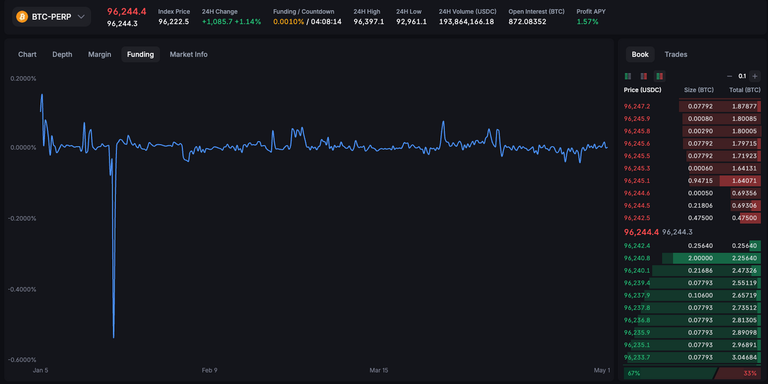Understanding the Basis Trade?

In the asset trading market, the basis refers to the difference between the futures (perpetual) price and the spot price.
Basis Trade is an arbitrage strategy that uses this price difference to gain profits regardless of the direction of the market. Hedge funds and market makers also operate on a large scale to reduce the risk-free arbitrage and price differences between exchanges.
This strategy focuses on the premium or discount resulting from price distortion or imbalance between markets, rather than the volatility of asset prices. Distortion or imbalance eventually balances out, but the imbalance before this balance is achieved becomes a point of profit.
Screenshot 2025-05-01 at 8.51.47PM.png
Perpetual Futures Funding Rate Fluctuation
There are two types of basis.
Positive Basis
When the futures price is higher than the spot price, it usually occurs in a bull market. As demand for the asset increases due to expectations of a market rally, leveraged long positions increase. This causes the futures price to have a premium.
Negative Basis
When the futures price is lower than the spot, it occurs in a bear market or when market participants are in a panic zone. This occurs when asset demand decreases sharply due to fear of a market decline and leveraged short positions increase. The market tilts toward risk aversion and futures selling pressure increases.
Basis trades are based on traditional futures (Cash-and-Carry Arbitrage) and perpetual futures (Perpetual Futures).
In both types, you buy the spot and sell the futures for the same value, i.e., take a short position.
For example, if you buy 1 BTC spot, you sell 1 BTC future.
Let's take an example based on perpetual futures, which are traded a lot by virtual asset market participants.
Perpetual futures have no expiration, and the difference between the futures and spot prices is adjusted by the funding rate. If the futures price is higher than the spot price, long positions will cool excessive longs by paying interest to shorts, thereby filling the gap.
Let's assume the current funding rate is 0.03%.
Then, buy 1 BTC spot and sell 1 BTC perpetual future. Selling perpetual futures becomes a neutral position as it is hedged by buying spot, and only generates a funding profit of 0.03%. It can be used in situations where the funding rate is continuously positive.
This basis trade is mainly used by institutional investors, quant traders, and whale individual investors.
There is a constant risk that the funding rate will fluctuate, and there is a clear risk of liquidation when using high leverage. It can be used for assets with abundant liquidity, and it should be done on a highly reliable exchange.
In the highly volatile virtual asset market, it is a way to make stable profits while studying the market movements, but it can maintain efficiency when the leverage market is overheated to some extent and maintained in a certain direction.
It may seem simple, but it is a strategy that requires understanding of the market, understanding of basic asset hedging, and basic asset management skills.
It is a strategy that can be applied while studying step by step and checking the rate of return without being too greedy.
You can check the funding fee for virtual assets' perpetual futures on Coinglass and on each exchange.
You can execute basis trades on exchanges that allow futures trading.
Due to reliability issues, it is recommended to trade on non-Chinese exchanges as much as possible.
Centralized exchanges: Backpack, Kraken, Gemini
DEX exchanges: Raydium Perp, Jupiter Perp, Drift, Zeta
Congratulations @pleasingeyes! You have completed the following achievement on the Hive blockchain And have been rewarded with New badge(s)
Your next target is to reach 50 upvotes.
You can view your badges on your board and compare yourself to others in the Ranking
If you no longer want to receive notifications, reply to this comment with the word
STOPCheck out our last posts: